This post is also available in: Italian
In addition to gardens, the surroundings of Florence are full of excellent nurseries, mostly in roses. By following our itinerary, visitors will come across irises, hydrangeas, Mediterranean plants, unusual species, and ancient varieties of fruit plants. Alternatively, or in addition, there’s a shorter itinerary which can be enjoyed by bicycle: Florence and surroundings/2.
There are also numberless gardens, in the city and on the surrounding hills: almost all of them are included in our special recommendation “Discovering Gardens: Florence and surroundings”.
Nurseries
The map shows the nurseries and the other suggested locations included in our itinerary.
Distances are mentioned as well, in order to better plan your visit.
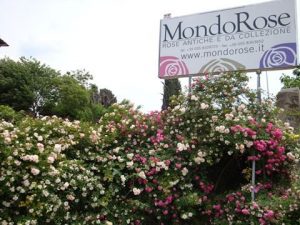
A nursery with a collection of over 500 varieties of ancient, botanical, English and modern collectable roses, as well as hybrids of “Moschata”, berry vines, and re-flowering shrubs.
Distances to nearby nurseries: 11 miles to Vivaio degl’Innocenti – 16 miles to Botanica La Romola – 36 miles to Terrecotte Venturi – 19 miles to Vivai Belfiore – 19 miles to Le Rose di Firenze.
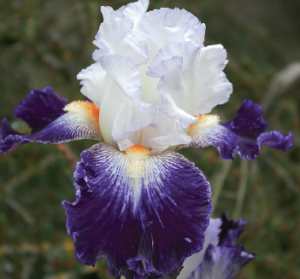
This nursery produces Iris spp. , perennial herbaceous plants, flowering shrubs, Hemerocallis spp., aquatic plants and roses. It also deals with the design, construction, and maintenance of gardens, parks, and terraces, as well as the construction of irrigation systems, specialized pruning, and tree-climbing services.
Distances to nearby nurseries: 5 miles to Botanica La Romola – 11 miles to MondoRose – 18.6 miles to Terrecotte Venturi – 9.3 miles to Vivai Belfiore – 5.6 miles to Le Rose di Firenze.
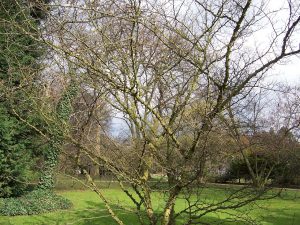
La Romola is specialized in researching and experimenting with new, rare and unusual botanical species from all over the world.
Thanks to the great passion of its owner, who often travels abroad to discover new plants, the choice of the plants to be cultivated is particularly painstaking – in fact, it always takes into account the local climate, the average rainfall, and, of course, the very types of soils available in our Country.
Distances to nearby nurseries: 16 miles to MondoRose – 5 miles to Vivaio degli Innocenti – 12.4 miles to Vivai Belfiore – 7.5 miles to Le Rose di Firenze/Magi.
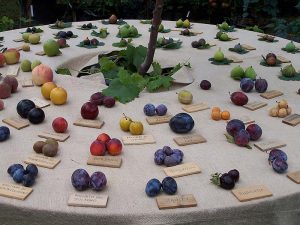
This is a park-nursery with over 1000 varieties of endangered fruit plants, native trees and shrubs of the Mediterranean scrub; there is also an olive grove, with valuable varieties of oil, as well as several potted fruit plants. Every year, Vivai Belfiore hosts “Pomarium” (www.pomarium.net), a market exhibition of ancient and rare fruit plants.
Distances to nearby nurseries: 2.5 miles to Vivaio Magi – 19.2 miles to MondoRose – 9.3 miles to Vivaio degli Innocenti – 12.4 miles to Botanica La Romola – 17.4 miles to Terrecotte Venturi
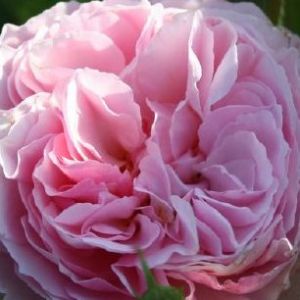
Le Rose di Firenze (Photos taken from the nursery website)
This nursery is specialized in the online sale (but also by appointment) of scented garden roses, ancient and modern. In particular, it offers the most beautiful varieties of “David Austin”, “Kordes”, “Meilland”, “Nirp”, “Pemperton”, “Pulsen”, “Tauntau”, and “Tom Carruth”.
It is also currently introducing other shrubs and creepers, including collections of hydrangeas (Hydrangea spp. ), Abelia spp., Spiraea spp. , Clematis spp. , aromatic and herbaceous perennials, as well as a wide range of garden furnishings, tools and assorted items.
The official website and the dedicated blog are also very interesting, packed with precious information and advice, including the best combinations, historical news, and stories.
On the website, the roses are listed and described both by type (ancient shrubs, modern shrubs, vines, etc.) and by colour to help customers making the right choice.
Distances to nearby nurseries: 4.3 miles to Vivaio Borgioli Taddei (see “Andar per vivai in bicicletta: Firenze e dintorni/2” itinerary) – 11.8 miles to MondoRose – 5.6 miles to Vivaio degli Innocenti – 7,5 miles to Botanica La Romola – 18.6 miles to da Terrecotte Venturi.
Must-see Gardens in Florence
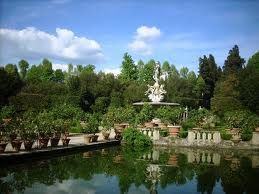
Boboli Gardens (Giardino di Boboli) is a historic park in the city of Florence. It extends behind the Pitti Palace, which was for nearly four centuries the residence of the grand dukes of Tuscany and for a short period of the kings of Italy. The Medici family was the first to ensure its accommodation, creating the model of the Italian garden that became an example for many European courts.
The large surface area of the Garden covers more than 485,000 square feet, expanded considerably in the seventeenth century, divided evenly along two main axes, from which develops the varied plot of the plants: not spontaneous, but rationally ordered and divided by hedges, terraces, avenues and paths that introduce to particular environments: clearings, gardens fences, buildings.
The fashion designer Gucci is currently funding the renovation of the Garden.
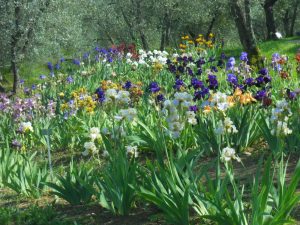
This iris garden (Giardino dell’Iris) is in Piazzale Michelangiolo (Fi). It was built in 1954 with the aim of hosting an annual international competition, the “Florence Prize”, acknowledging the best varieties of Iris.
The Garden was set up on a previously cultivated hilly terrain, so most of the tall plants are olive trees. Other species of the Tuscan tradition were used during the preparation phase including cypresses, Judas trees (Cercis siliquastrum L.), strawberry trees (Arbutus unedo L. ), laurels (Laurus nobilis L. ), and some varieties of maples.
The Garden is home to tall-bearded irises, medium-bearded irises, edging and dwarf irises. There are also Siberian irises (Iris sibirica, Iris spuria, Iris californica), and around the lake several Iris louisiana, Iris pseudoacorus, and the Japanese Iris kaempferi. The bearded and non-bearded Iris species typical of our regions are represented by Iris pallida, Iris germanica, Iris florentina, Iris setosa, Iris unguicolaris, as well as Iris ochroleuca.
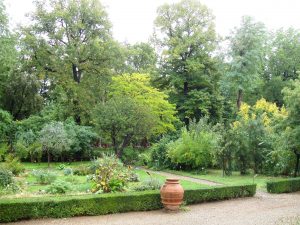
The Botanical Garden of Florence, known as “Giardino dei Semplici”, was built as a collection of officinal plants (the so-called “Semplici”) in 1545, and it is among the three oldest gardens in the world, along with that of Pisa and Padua.
The design of the flower beds recalls both the medieval Hortus conclusus dedicated to officinal and aromatic herbs and the secret garden of Renaissance villas. The greenhouses, located both in the garden and in the main building, are cold and warm facilities that house collections of ferns, epiphytic plants, begonias and bromeliads.
The greenhouses are packed with exotic plants such as Coffea arabica, the traveler’s tree – Ravenala madagascariensis, the Amorphophallus titanum, the Musa × paradisiaca banana, as well as many collections of orchids, carnivorous plants, cacti, cycads, and citrus fruits. This botanical garden currently features 9.000 plant specimens.
Renowned Artisans in Florence
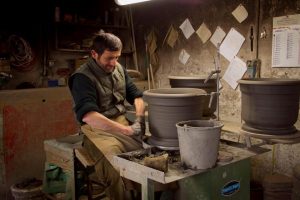
Vasco Venturi (photos taken from the Internet)
The Venturi family has been producing pots, pans, pans, bean pots, and brick chicken cookers for four generations: everything has always been made by hand with refractory clay, and then painted with lead-free crystals, particularly suitable for food.
Tuscan tradition is thus perfectly blended with traditional kitchenware for everyday use.
Upon using these terracotta items for the first time, remember to immerse them in cold water for one night to close the pores and avoid the release of smells when cooking or serving food.
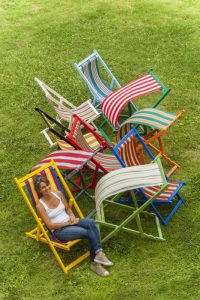
StripeYou, in Certaldo (Florence):
Her mother was a very creative person thus her daughter Federica Bruzone has recently created Stripe You, a registered trademark that has reinvented the classic “olona/baiadera” fabric. The latter comes with coloured stripes, is made in Tuscany and it’s particularly resistant to harsh weather. It is widely used to craft incredibly cheerful objects like garden furniture (deck chairs, director’s chairs, folding beds and stools, tables, coffee tables, etc.), bags, backpacks, key rings, aprons, gardening belts, pot sacks, cushions, placemats, runners, glass holders, coat hangers, beach bags, foldable bags, bottle holders, handyman bags, wrapped buttons, cases, slippers, sandals, wallets, etc., etc., etc.
Francesca Galtabiano Gioielli (Florence):
A jewellery designer, Francesca creates unique pieces and a range of products inspired by fairy tales and small animals thriving in the woods, such as snails (Caracalla collection), frogs (Rinascimento collection), and bullfrogs (Postrosp collection) – there are all incredibly cute, funny, and very special works of art.
Accommodation and Refreshments
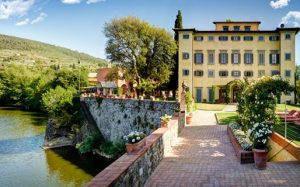
Villa La Massa dates back to the XVI century – the time of the Medici family – and was built on the banks of the Arno river, a few miles south of Florence and at the very gates of the Chianti region.
More than 400 years ago, Santi Landini, a famous publisher from the local aristocracy, decided to build his own summer residence on the banks of the Arno River.
The Villa remained the property of the Landini family until 1788 when it was purchased by Cardinal Giovanni Rinuccini. After several changes of ownership and some modifications, it was transformed by the Sears family into a charming hotel in 1953.
Since then, many famous guests have stayed at Villa La Massa, including Gregory Peck, Winston Churchill, Barbara Hutton, Elisabeth Taylor and Richard Burton, just to name a few.
In 1984, all the three buildings of the complex – the noble villa, the old mill from the 1400s and the small residence – were transformed into luxury hotels. Villa d’Este Group eventually bought it in 1998, and since then the whole property has undergone several major renovations.
A large ornamental garden is still under construction, featuring hedges and roses, as well as an agricultural-naturalistic area with an olive grove in a meadow of wildflowers. This area will also include a double border of perennial herbaceous plants blooming in succession, mostly featuring peonies and iris.
This post is also available in: Italian


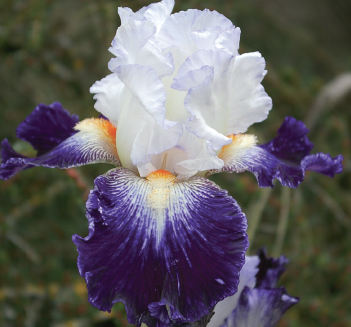
Leave a Reply